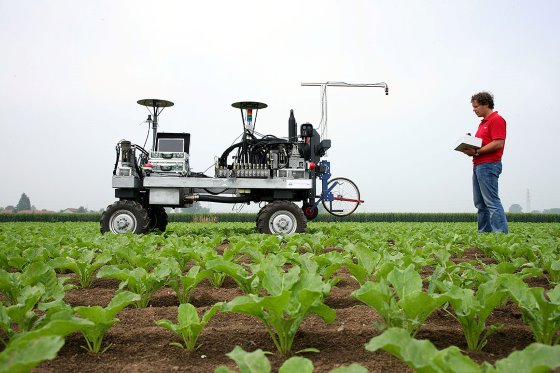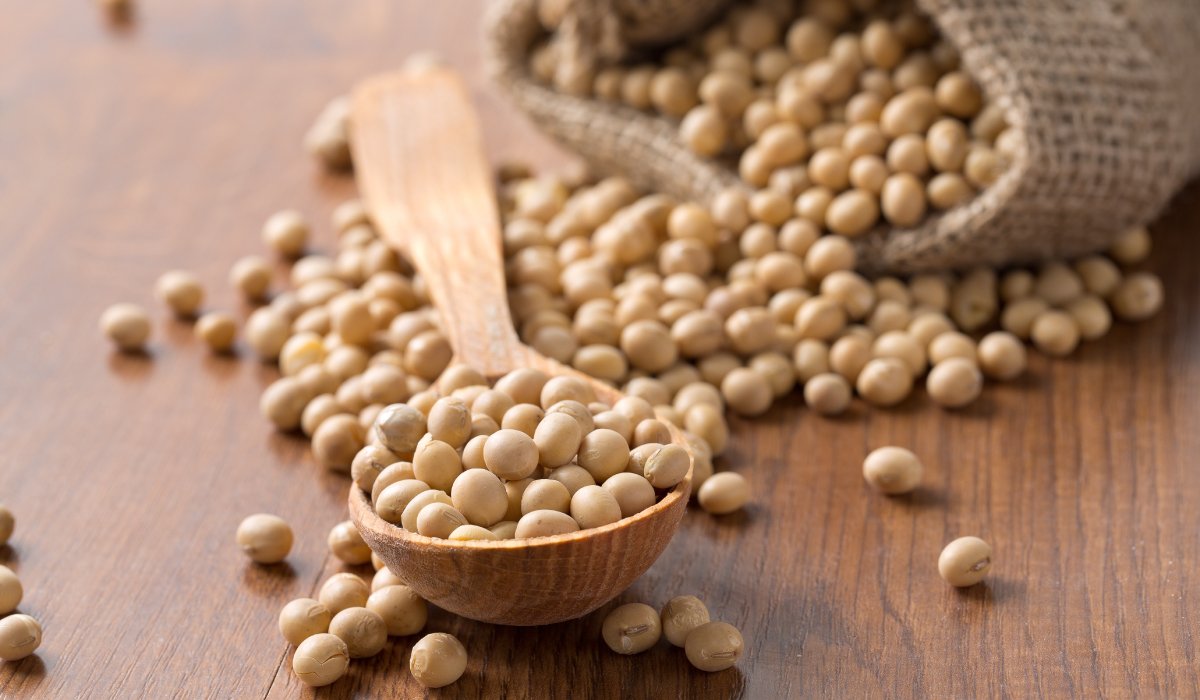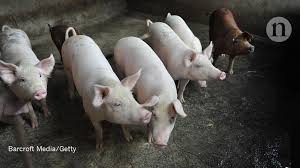The autonomous robotic system called Robotti from Danish company AgroIntelli is helping farmers across Europe, the UK, Australia, and further afield to make up for the acute labor shortages.
Prof Michiel Scholtz, specialist researcher in applied animal genetics at the Agricultural Research Council, shares a South African perspective on livestock production and how it relates to greenhouse gases and water usage.
South Africa's 2021/22 summer crop harvest is at decent levels, with soybeans reaching a fresh high
- Hits: 748
South Africa's 2021/22 summer crop harvest is in full swing across the country.
South Africa’s agricultural sector has had two consecutive years of strong growth, with expansion in all subsectors, i.e., livestock, field crops and horticulture. This year will be a break from the 2020 and 2021 strong performance. We expect the sector’s gross value added to fall by roughly 3-5% year on year given the high base from 2021. The overall field crops harvest will likely be lower than the previous season, although some crops such as soybeans and sunflower seed promise a large harvest. But this will not be the only source of potential contraction in the sector. The livestock sector, which accounts for roughly half of the sector’s gross value added, continues to face numerous challenges. First, the generally higher grains and oilseed prices, a key feed ingredient, have presented increased cost pressures to livestock and poultry farmers since 2020. For example, yellow maize prices were up by 38% year on year on 23 June 2022, trading at R4 357 per tonne.
While the farmers were somewhat able to manage the rising feed costs in the past two years, the current season has presented new challenges: a vast outbreak of foot-and-mouth disease as well as continued occurrences of swine flu and avian influenza outbreaks. South Africa has had 91 foot-and-mouth disease outbreaks in previously disease-free zones. The disease has for the first time in history spread outside the demarcated foot-and-mouth disease zone and is now active in five provinces, namely, Limpopo, KwaZulu-Natal, North West, Gauteng and Free State. While the outbreak does not necessarily mean a wide slaughtering of cattle for farmers and has now, encouragingly, been quarantined in various sites or farms, the economic impact still cuts deep. The impact on livestock auctions is huge. Moreover, bans by many countries on exports of South Africa’s livestock products constrain the growth of the sector and harm the potential for black farmers to reap the benefits from an increasingly export-oriented livestock sector. South Africa’s beef industry is aggressively building its export activity, with exports having grown nearly seven-folds over the past two decades, reaching 54 334 tonnes in 2021 (see Exhibit 1 in the attached file). But we are still not able to export our top-quality beef products to the USA, UK and EU markets where the returns will be much higher than exporting to the Middle East and other smaller markets.
The frequent outbreak of the foot-and-mouth disease risks reversing or slowing the export drive that the beef industry has embarked on. Weaker exports could also translate to softer domestic beef prices at a time when the feed costs – grains and oilseeds – are elevated. This ultimately adds financial strain on farmers. The financial pressure is not limited to the cattle industry but also to sheep, goats, pigs and poultry. For instance, China has temporarily suspended imports of South Africa’s wool for roughly three months due to the foot-and-mouth disease outbreaks. China is a significant market, accounting for roughly 70% of South Africa’s wool exports. The current export ban has a broad negative financial impact on the wool industry and the communities that rely on the industry.
Livestock is also one of the subsectors with the deep involvement of farmers from the former homelands’ regions of South Africa. For example, the National Agricultural Marketing Council estimates suggest that black farmers account for 18%, 13% and 34% of wool, mohair, and cattle production, respectively. The accuracy of these data is debatable, but the point here is that a sizable share of agricultural output by black farmers is affected by these financial pressures. We highlight this data to note that these new entrant farmers might not have financial buffers to carry them through in a tough livestock market, as we already hear from established commercial farmers about these financial pressures.
Keeping in mind the focus of the Agriculture and Agro-processing Master Plan on inclusive growth and employment creation in the agricultural sector, efficient prevention and management of animal diseases and maintenance of animal health is critical. Government has a critical role to play here and the legislative, budgetary and coordinating tasks of public veterinary services and animal health services are absolutely vital in protecting our national livestock herd and enabling the growth that the sector desperately needs.
The Department of Agriculture, Land Reform and Rural Development established an Animal Biosecurity Task Team, which we understand completed its task with crucial recommendations for improving the current challenges. The report should be made public, and its recommendations implemented urgently. This could provide a platform for effective collaboration between the private sector and the government in placing measures in place to curb the spread of diseases and improve the health of all sectors of the livestock sector.
Importantly, for key markets for the wool industry such as China, the Department of Agriculture, Land Reform and Rural Development should actively engage the Chinese authorities to resume exports, as we believe there was the framework for engagement from the previous episodes of this nature of outbreaks. The engagement is crucial as China has slowly opened its economy from the tough lockdowns. Our government should move with speed on its engagement. In the case of rising feed costs, the potential rains will be a saving grace that natural grazing veld will continue recovering well and assist the livestock, to an extent.
Overall, South Africa’s agricultural sector faces numerous challenges, which range from network industry, and broad policy matters such as a need for increased export markets. But in the near term, resolving the constraints above facing the livestock industry would bring a slight relief.
Weekly highlights
South Africa’s consumer food price inflation accelerated in May
We are in a period of elevated prices, and food is at the core of these increases. For example, in May, South Africa’s consumer food price inflation accelerated to 7,8% y/y, from 6,3% in the previous month. This is the quickest pace since March 2017. The increase was broad base on all food products in the inflation basket. This largely mirrors the uptick we have been seeing in the global agricultural commodity prices, and indeed the domestic market.
Importantly, we are now also starting to see the spillover the Russia-Ukraine war had on agricultural commodity prices transmitted into retail food prices. In fact, for the grain-related and vegetable oils products, we will likely see a continuous mild uptick in the coming month or two, which could push up mildly the headline food consumer price inflation number further. Since the Russia-Ukraine war began and disrupted the global grains market, the global agricultural commodity prices have increased significantly, with the FAO's Global Food Price Index in May averaging 157 points, which is up 22% y/y, coming from a record high seen in March.
The disruption in the palm oil market, and indeed the entire vegetable oils market, the ban on wheat exports by India, and the expected lower wheat harvest in the 2022/23 production season are added upside risks that could sustain prices at higher levels. We, however, don’t see potential further increases in the global agricultural commodity prices, but that prices could hover at current elevated levels for some time. South Africa, which is interlined with global agricultural markets, has also experienced increased agricultural commodity prices. The result of these developments is the recent uptick in the cereals, and oil and fat products prices in the consumer food price inflation basket. These could remain elevated, in line with our expectations of agricultural commodity prices.
Nevertheless, we still think the outlook on food product prices will remain mixed, despite the recent broad increase in product prices. In the case of fruits and vegetables, South Africa has a sizable harvest and the disruption in fruit exports within the Black Sea region could add downward pressure on domestic prices; Therefore, we hold a generally favourable view of these product price directions for the coming months.
The one essential product whose price trend remains uncertain is meat. The recent outbreaks of foot-and-mouth disease have led to the temporary closure of some key export markets for the red meat industry, thus potentially adding downward pressure on prices. Still, this will be dependent on the cattle and sheep slaughtering activity, which for now remains robust, with 197 712 head of cattle slaughtered in April 2022 (-2% y/y), and 318 155 head of sheep slaughtered in the same month (-10% y/y). Conversely, there are fears of a potential increase in poultry product prices, which could lessen the benefit of softer red meat prices.
Overall, various factors in the food market will likely push in opposing directions in the coming months. Thus, we believe that South Africa's consumer food price inflation could average just above 6,0% y/y in 2022 (from 6,5% in 2021). The base effects, along with meat, fruits and vegetables, will likely provide a constructive price inflation path ahead. With that said, the next month or two will likely show elevated consumer food price inflation, with moderation in much of the second half of the year.
Data releases this week
We start the week with a global focus, where, today, the United States Department of Agriculture (USDA) will publish its weekly US Crop Progress The planting activity has been completed, and thus we now focus on the crop-growing conditions. In the previous release, in the week of 19 June 2022, about 70% of the maize crop was rated good/excellent, compared with 65% in the corresponding week in 2021. Moreover, about 68% of the soybean crop was rated good/excellent, compared with 60% in the same week last year. On Thursday, the USDA will release the US Weekly Export Sales data.
On the domestic front, on Tuesday, the Crop Estimates Committee will release its fifth summer crop production estimates. We don’t expect any major adjustments from the current estimates, aside from a marginal uptick in the soybeans harvest estimates.
On Wednesday, SAGIS will release the maize Weekly Producer Deliveries data for the week of 24 June 2022. This data will help us get insight into the progress of the maize harvest activity. In the previous release of the week of 17 June, 2,7 million tonnes of maize had already been delivered to commercial silos, out of the expected harvest of 14,7 million tonnes. Moreover, the soybean harvesting process is nearly complete. In the week of 17 June 2022, about 1,9 million tonnes had already been delivered to commercial silos. The data for 24 June 2022 will likely show additional small volumes of deliveries. In terms of sunflower seed, in the week of 17 June 2022, about 594 236 tonnes had already been delivered, against an expected harvest of 963 000 tonnes (second largest on record).
On Thursday, SAGIS will publish the Weekly Grain Trade data for the week of 24 June 2022. In the previous release on 17 June 2022, which was the seventh week of South Africa's 2022/23 maize marketing year, the weekly exports amounted to 99 019 tonnes. The key markets were Japan, Taiwan, Vietnam and the Southern Africa region. This brought the total 2022/23 exports to 563 796 tonnes out of the seasonal export forecast of 3,2 million tonnes. This is slightly down from 4,1 million tonnes in the past season due to an expected reduction in the harvest.
South Africa is a net importer of wheat, and 17 June was the 38th week of the 2021/22 marketing year. The total imports are now at 1,17 million tonnes out of the seasonal import forecast of 1,48 million tonnes (slightly below the 2020/21 marketing year imports of 1,51 million tonnes because of a large domestic harvest). About 25% is from Argentina, 23% from Lithuania, 18% from Brazil, 14% from Australia, 13% from Poland, 4% from Latvia and 3% from the US.
If one looks into South Africa’s wheat imports data for the past five years, Russia was one of the major wheat suppliers, accounting for an average share of 26% a year. This has now been replaced by the above-mentioned suppliers.
Also on Thursday, Statistics South Africa will release the Producer Price Index (PPI) data for May 2022.
China’s pig farmers mired in boom-bust cycle
- Hits: 1198
With pork the most popular protein on Chinese tables, pig breeding can be very profitable with gross margins rising above 30% for some producers when there’s a shortage, driving farmers to expand capacity.
A challenging paper appeared in a recent issue of the World’s Poultry Science Journal.
- The future of livestock farming -2022
- South Africa poultry producers missing out on export market with lax livestock health standards
- Scientists have a new suggestion to create more climate-friendly cows
- Antibiotic resistance detected in the food chain could have implications for human health, new study finds
Newsletter Subscribe
AGRI NEWS NET "LIVE" FEED
- South African farmers are increasingly vulnerable to climate-related disasters such as fires, frost, and floods, exacerbated by low adoption of agricultural insurance. Despite the growing unpredictability of weather patterns, many farmers remain uninsured, leaving them exposed to significant financial losses.
- The South African agriculture and land policy discourse is at risk of stagnating, mirroring the inertia seen in other developmental areas. Over the past three years, the government's acquisition of 2.5 million hectares of land under the Proactive Land Acquisition Strategy has resulted in underutilization or short-term leasing to farmers who lack the capital to maximize productivity.
- Gewasbeskerming is 'n mooi groot woord- dit klink baie mooi op die oor.. maar dit is baie mooi voorberei en kos baie geld en pas in jou produksiesyfers in- sodat jy nog 'n wins kan maak- Alles lyk mooi- opbrengs is goed- maar die vraag is hoeveel van die sogenaamde beskermingmiddels is nog in plant en hoeveel daarvan kom in jou lyf met groot negatiewe gevolge.
- Die DA in Gauteng sê inwoners het te doen met die gevaar van voedselonsekerheid weens die gebrek aan steun deur die provinsiale regering vir boere. Bronwynn Engelbrecht van die DA sê die jongste bruto binnelandse produk-data oor die landbousektor onthul die bedryf het in die derde kwartaal van 2024 ‘n skokkende afname van 28,8-persent beleef, wat die BBP-groei afgerem het met 0,7-persent.
Popular News Tags
AGRI NEWS NET AUDIO CAST Feeding-
- What Needs to Change in Farming and Agriculture in 2025
- AGRI NEWS RUSH - News Headlines of the Week 18/01/2025
- Farmer safety in South Africa in 2025
- The Economics of Farming and Agriculture in South Africa 2025
- The global wine market 2025
- AGRI NEWS RUSH - News Headlines of the Week 11/01/2024
- Artificial Intelligence: All That Glitters Is Not Gold
- GLOBAL WATER OUTLOOK TO 2025 Averting an Impending Crisis


















